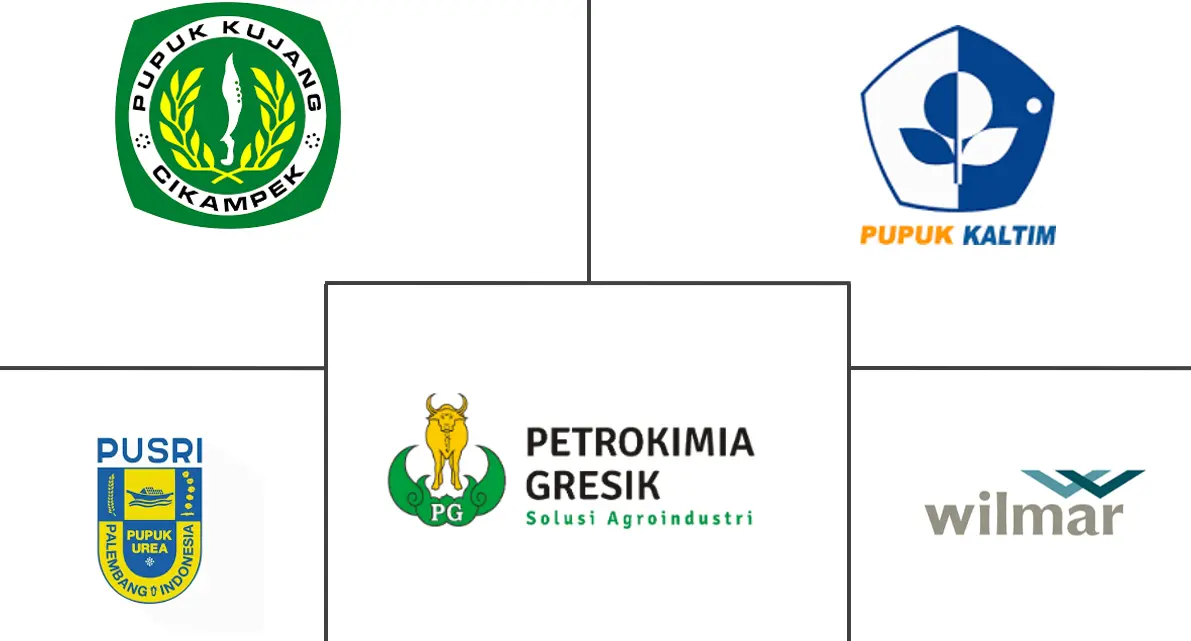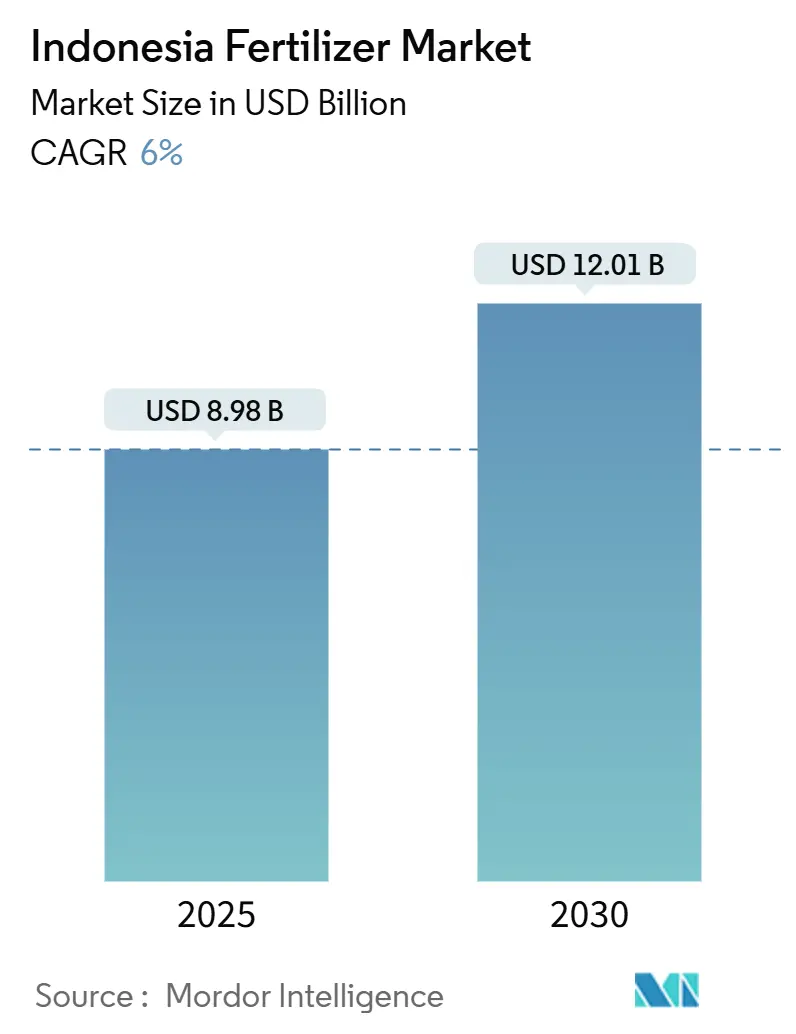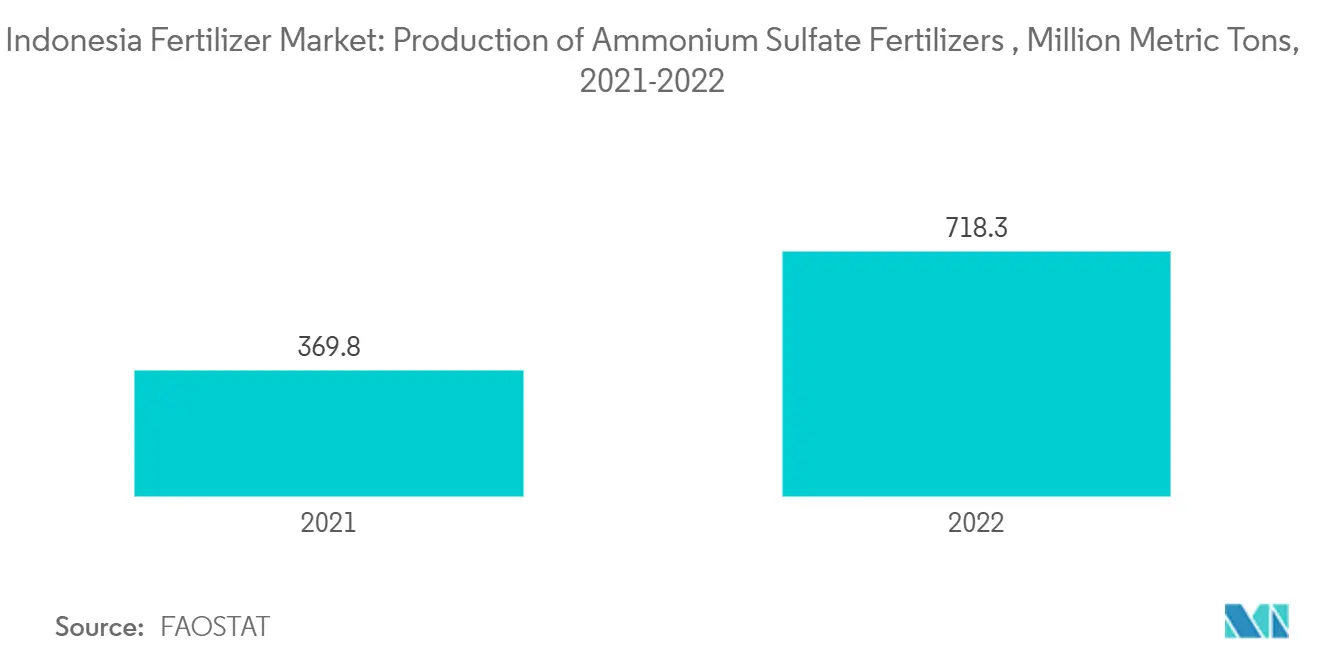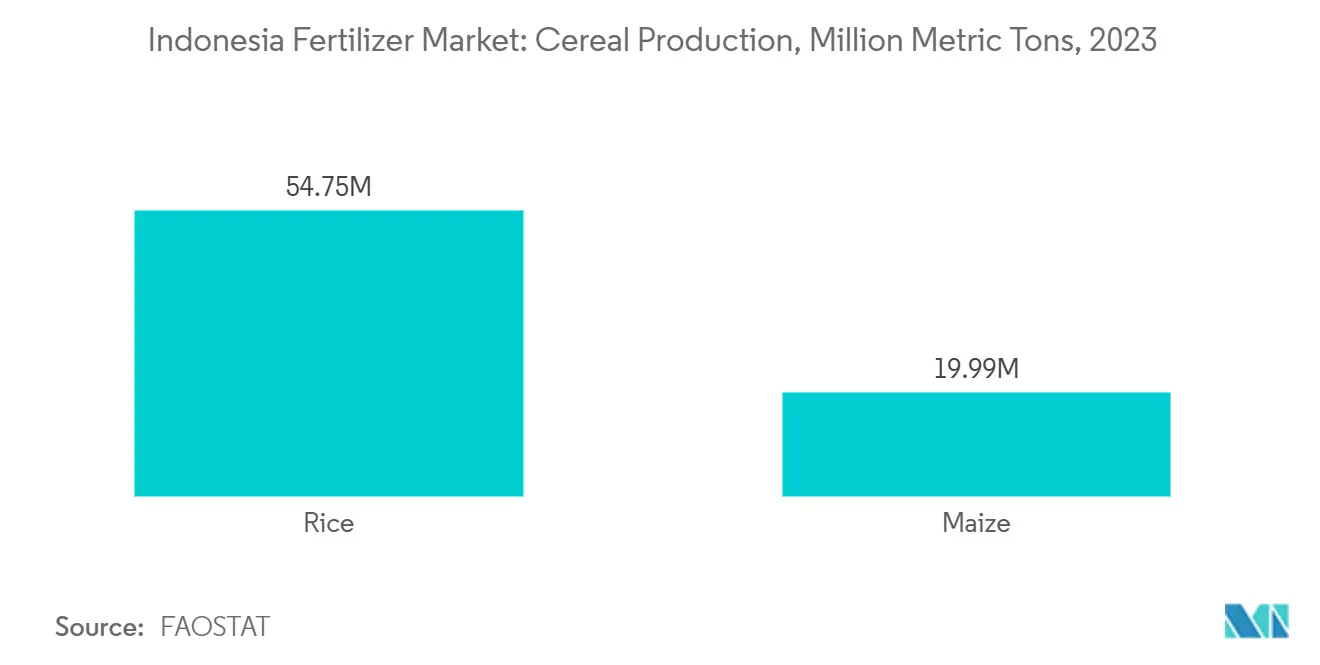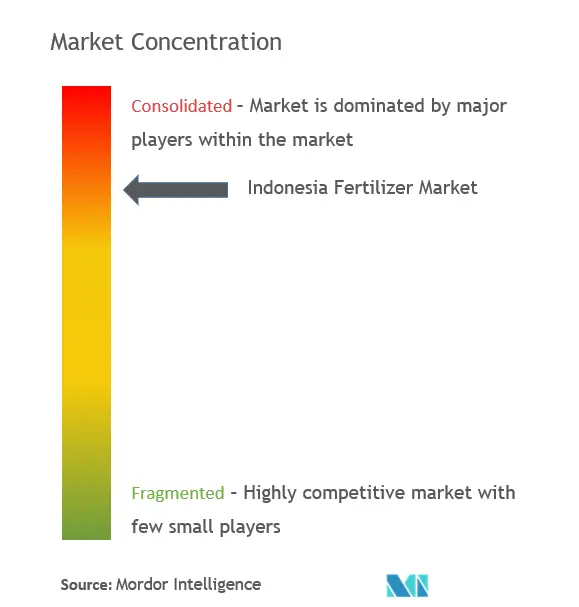Indonesia Fertilizer Market Analysis
The Indonesia Fertilizer Market size is estimated at USD 8.98 billion in 2025, and is expected to reach USD 12.01 billion by 2030, at a CAGR of 6% during the forecast period (2025-2030).
The Indonesian fertilizer market is essential to the country's agricultural sector, which contributes 13-15% to its GDP. The market growth is driven by fertilizer demand for rice, oil palm, and plantation crops, along with the country's emphasis on food security and sustainable agriculture. Indonesia's fertilizer industry combines domestic production with imports, with state-owned PT Pupuk Indonesia dominating local manufacturing of urea, ammonium nitrate, and other primary fertilizers.
Indonesia's population of over 283.5 million in 2024 is among the largest in Southeast Asia. The growing population drives increased food demand, particularly for staple crops like rice. Fertilizers play a vital role in enhancing crop yields and maintaining food security. Rice yield in Indonesia increased from 5,237.8 Kg/ha in 2022 to 5,285.2 Kg/ha in 2023. The country's rice farming sector, critical for domestic consumption and exports, requires substantial nitrogen-based fertilizers, including urea and ammonium nitrate, to sustain productivity and meet national food requirements.
The Indonesian government plays a pivotal role in supporting the fertilizer market through subsidies, which makes fertilizers more affordable for farmers. The Subsidized Fertilizer Program helps lower the cost of key fertilizers, particularly for smallholder farmers. The government allocates subsidies for fertilizers like urea, SP-36, and ZA, making them available at lower prices to millions of small farmers, thus encouraging better fertilizer use to boost productivity and reduce poverty in rural areas. For instance, the total allocation of subsidized fertilizers set by the government in 2023 is 7.85 million tons. In detail, Urea fertilizer is 4.64 million tons and NPK is 3.21 million tons. Thereby fertilizers easily acceseble to the customers in Indonesia.
Indonesia Fertilizer Market Trends
Nitrogenous Fertilizers Holds a Significant Segment by Straight Fertilizers
Nitrogenous fertilizers indeed hold a significant share in the straight fertilizers segment in Indonesia. Nitrogen is one of the most essential nutrients for plant growth, and its use is particularly crucial for crops like rice, which is a staple food in Indonesia. Nitrogen fertilizers promote leaf and stem growth, helping crops reach their full potential in terms of size and yield.
The increasing production of nitrogenous fertilizers ammonium sulfate in Indonesia is significantly driving the country’s fertilizer market, influencing both domestic agricultural productivity and the overall economy. For instance, according to FAOSTAT, the production of ammonium sulfate fertilizers in Indonesia was 369.8 million metric tons in 2021, which increased by 718.3 million metric tons in 2022. Ammonium sulfate is a critical component in improving crop yields and maintaining soil fertility, especially in a country like Indonesia where agriculture plays a central role in economic growth.
Rice is the primary food crop in Indonesia, and nitrogen fertilizers are essential for boosting yields and maintaining soil fertility in paddy fields. Among fertilizers, nitrogenous types like urea are often seen as more affordable, making them accessible to a wide range of farmers, from large-scale operations to smaller, subsistence farms.
Grains And Cereals Dominant the market
Grains and cereals play a dominant role in the Indonesian fertilizer market, largely due to the country’s agricultural focus on staple crops like rice, maize, and wheat, which require significant fertilizer input to optimize yields and ensure food security. Fertilizer use in grains and cereals is integral to the productivity of Indonesia’s agricultural sector, which is essential for both domestic consumption and export.
Indonesia is one of the largest producers and consumers of rice in the world. For instance, according to FAOSTAT, rice production in Indonesia was 54.4 million metric tons in 2021, which increased by 54.7 million metric tons in 2023. It is a staple food and a key crop that requires substantial fertilizer application to maintain productivity. The major types of fertilizers used for rice cultivation include urea (nitrogen), phosphate fertilizers (DAP), and potash fertilizers. Another important crop in Indonesia is maize (corn), which has seen increasing demand due to its use in food production, animal feed, and biofuel industries. Like rice, maize cultivation requires a balanced application of NPK (Nitrogen, Phosphorus, and Potassium) fertilizers to improve yield and quality.
Blended NPK fertilizers are becoming increasingly popular for grains and cereals. These custom-made blends are tailored to meet the specific nutrient needs of crops, improving fertilizer use efficiency and promoting better crop health. Blended fertilizers also cater to local soil deficiencies, further driving the market. In areas where soil tests reveal deficiencies in specific nutrients like potassium or phosphate, blended NPK fertilizers are used to rectify these imbalances. This practice is becoming more common among Indonesian maize and rice farmers.
Indonesia Fertilizer Industry Overview
The Indonesia fertilizer market is highly consolidated, with key players holding a major share in the market. The state-owned enterprises such as PT Pupuk Kalimantan Timur, PT. Pupuk Sriwidjaya Palembang, PT Petrokimia Gresik, PT Pupuk Kujang, Wilmar International Limited, and PT Pupuk Iskandar Muda, which are subsidiaries of PT Pupuk Indonesia Holding Company, dominates the market. Major players in the market are making partnerships their most adopted strategy to consolidate their positions in the market.
Indonesia Fertilizer Market Leaders
-
PT Pupuk Kujang
-
PT. Pupuk Kalimantan Timur
-
PT. Pupuk Sriwidjaya Palembang
-
PT Petrokimia Gresik
-
Wilmar International Limited
- *Disclaimer: Major Players sorted in no particular order
Indonesia Fertilizer Market News
- December 2024: Pupuk Indonesia has distributed 7.25 million tons of subsidized fertilizers, achieving 100.5% of the government-mandated target. This includes 3.66 million tons of urea fertilizer, 3.49 million tons of NPK fertilizer, 42,706 tons of specialized NPK formulas, and 46,521 tons of organic fertilizer.
- October 2023: Pupuk Sriwijaya to build fertilizer factory in Palembang Indonesia. The production capacity of the Pusri IIIB Factory is planned to be 1350 tons of ammonia per day or 445 500 tpy and for urea fertilizer it will reach 2750 tpd or 907 500 tpy.
Indonesia Fertilizer Industry Segmentation
Fertilizers are natural or artificial substances containing chemical elements that improve the growth and productivity of plants. Fertilizers enhance the soil's natural fertility or replace the chemical elements taken from the soil by previous crops. The Indonesia fertilizer market is segmented by type Complex, Straight (nitrogenous, phosphatic, potash, secondary nutrient, and micronutrients), crop type (grains and cereals, pulses and oilseeds, commercial crops, fruits and vegetables, and Turf and Ornamental crops). The report offers a market estimation and forecasts of the market size in value (USD ) and volume (metric ton) for all the mentioned segments.
| Straight Fertilizers | Nitrogenous Fertilizers | Urea | |
| Calcium Ammonium Nitrate (CAN) | |||
| Ammonia | |||
| Ammonium Nitrate | |||
| Ammonium Sulfate | |||
| Other Nitrogenous Fertilizers | |||
| Phosphatic Fertilizers | Mono-ammonium Phosphate (MAP) | ||
| Di-ammonium Phosphate (DAP) | |||
| Triple Superphosphate (TSP) | |||
| Other Phosphatic Fertilizers | |||
| Potash Fertilizers | Muriate of Potash (MOP) | ||
| Other Potash Fertilizers | |||
| Secondary Nutrient Fertilizers | |||
| Micronutrients | |||
| Crop Type | Grains and Cereals | ||
| Pulses and Oil Seeds | |||
| Commercial Crops | |||
| Fruits and Vegetables | |||
| Turf and Ornamental Crops | |||
| Nitrogenous Fertilizers | Urea |
| Calcium Ammonium Nitrate (CAN) | |
| Ammonia | |
| Ammonium Nitrate | |
| Ammonium Sulfate | |
| Other Nitrogenous Fertilizers | |
| Phosphatic Fertilizers | Mono-ammonium Phosphate (MAP) |
| Di-ammonium Phosphate (DAP) | |
| Triple Superphosphate (TSP) | |
| Other Phosphatic Fertilizers | |
| Potash Fertilizers | Muriate of Potash (MOP) |
| Other Potash Fertilizers | |
| Secondary Nutrient Fertilizers | |
| Micronutrients |
| Grains and Cereals |
| Pulses and Oil Seeds |
| Commercial Crops |
| Fruits and Vegetables |
| Turf and Ornamental Crops |
Indonesia Fertilizer Market Research FAQs
How big is the Indonesia Fertilizer Market?
The Indonesia Fertilizer Market size is expected to reach USD 8.98 billion in 2025 and grow at a CAGR of 6% to reach USD 12.01 billion by 2030.
What is the current Indonesia Fertilizer Market size?
In 2025, the Indonesia Fertilizer Market size is expected to reach USD 8.98 billion.
Who are the key players in Indonesia Fertilizer Market?
PT Pupuk Kujang, PT. Pupuk Kalimantan Timur, PT. Pupuk Sriwidjaya Palembang, PT Petrokimia Gresik and Wilmar International Limited are the major companies operating in the Indonesia Fertilizer Market.
What years does this Indonesia Fertilizer Market cover, and what was the market size in 2024?
In 2024, the Indonesia Fertilizer Market size was estimated at USD 8.44 billion. The report covers the Indonesia Fertilizer Market historical market size for years: 2019, 2020, 2021, 2022, 2023 and 2024. The report also forecasts the Indonesia Fertilizer Market size for years: 2025, 2026, 2027, 2028, 2029 and 2030.
Our Best Selling Reports
Indonesia Fertilizer Industry Report
Statistics for the 2025 Indonesia Fertilizer market share, size and revenue growth rate, created by Mordor Intelligence™ Industry Reports. Indonesia Fertilizer analysis includes a market forecast outlook for 2025 to 2030 and historical overview. Get a sample of this industry analysis as a free report PDF download.

